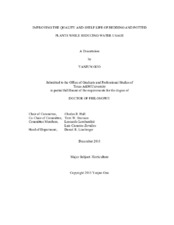| dc.description.abstract | Retail environments are rarely optimal for ornamental plants, and wilting caused
by water stress is a major cause of postproduction shrinkage. The objective of this study
was to determine the effect of reducing substrate moisture content (SMC) from 40% to
20% during bedding and potted plants greenhouse production on growth and
development, plant production and postproduction quality, and economic value.
Five experiments were conducted to evaluate the response of bedding plants
species/cultivars and the response of poinsettias to reduced SMC. In experiment 1, two
SMC levels were applied during greenhouse production to angelonia (Angelonia
angustifolia) ‘Angelface Blue’ and heliotrope (Heliotropium arborescens) ‘Simply
Scentsational’. Growth and physiological parameters were evaluated, as well as
subsequent postproduction quality during simulated retail conditions. 20% SMC
produced more compact angelonia with less inputs and higher postproduction quality.
Heliotrope grown at 20% SMC produced the same size plant as 40% SMC, but had a
higher visual quality compared with 40% SMC. In experiments 2 and 3, two SMC levels
(20% or 40%) were applied with four timing of application combinations to poinsettia
(Euphorbia pulcherrima) ‘Freedom Red’ in 2016 and ‘Christmas Eve Red’ in 2017.
Total production (TP) time was 14 (2016) or 12 (2017) weeks, during which vegetative
production (VP) occurred from week 33 (2016) or 35 (2017) to week 39 and
reproductive production (RP) continued from week 40 to 47. The four timing of
application treatments were: 40/40 = TP at 40% SMC; 20/40 = VP at 20% + RP at 40%;
40/20 = VP at 40% + RP at 20%; 20/20 = TP at 20% SMC. After simulated shipping in
the dark, plants were evaluated in a simulated retail environment with two packaging
treatments: no sleeve covering or plastic perforated plant sleeves covering container and
plant. Reducing SMC to 20% during TP or during RP reduced water usage during
production and produced more compact plants with increased postproduction quality. In
experiments 4 and 5, two SMC levels (20% or 40%) were applied during production of
six bedding plant species/cultivars Solenostemon scutellarioides 'French Quarter'
(coleus), Petunia × hybrida 'Colorworks Pink Radiance' (petunia), Lantana camara
'Lucky Flame' (lantana), Impatiens × hybrida 'Sunpatiens Compact Hot Coral' (SCC) and
‘Sunpatiens Spreading Lavender’ (SSL) (impatiens), and Salvia splendens ‘Red Hot
Sally II’ (salvia) greenhouse production. Considering production and/or postproduction
quality, using 20% SMC during greenhouse production is beneficial as an alternative
irrigation method for these cultivars of angelonia, heliotrope, coleus, petunia, impatiens
SSL, salvia and poinsettia, but not for impatiens SCC or lantana. | en |


